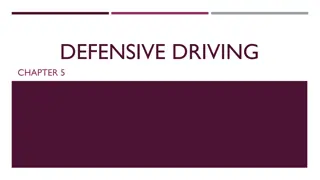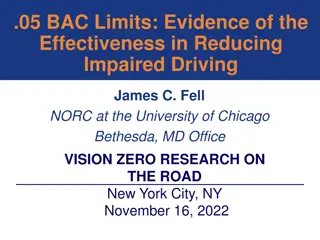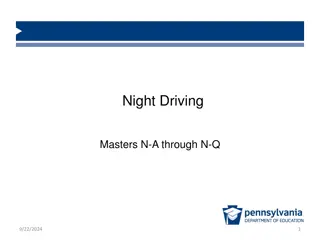Mastering Expressway Driving: Strategies and Techniques
Learn about the characteristics of driving on expressways, including reasons for lower collision rates, types of interchanges, safe driving strategies, entering an expressway properly, important factors to remember while driving, and strategies for safe expressway driving using the IPDE process. Explore tips for navigating entrance problems, increasing following distances, handling tailgating situations, and more.
Download Presentation

Please find below an Image/Link to download the presentation.
The content on the website is provided AS IS for your information and personal use only. It may not be sold, licensed, or shared on other websites without obtaining consent from the author. Download presentation by click this link. If you encounter any issues during the download, it is possible that the publisher has removed the file from their server.
E N D
Presentation Transcript
CHAPTER 11 DRIVING ON EXPRESSWAYS
11.1 CHARACTERISTICS OF EXPRESSWAY DRIVING OBJECTIVES 1. List five reasons why expressways have lower collisions rates than other highways. 2. Describe four different types of expressway interchanges. 3. List strategies for low-risk driving on expressways.
TYPES OF EXPRESSWAYS All-Directional Interchange Safe Driving Strategies Build experience gradually Concentrate on the driving task Cooperate with other drivers Advantages of expressways Expressway interchange Cloverleaf interchange Diamond interchange Trumpet interchange
11.2 ENTERING AN EXPRESSWAY OBJECTIVES 1. Explain how to enter an expressway properly. 2. Describe four possible entrance problems. 3. Explain why entering an expressway from the left is more hazardous than entering from the right.
IMPORTANT FACTORS TO REMEMBER WHEN DRIVING ON THE EXPRESSWAY Expressway Entrances Entrance Ramp Acceleration Lane Merging Area Steps for Entering 1. Make sure the entrance is the one you want. Look for a red and white wrong way or do not enter sign. Once on the entrance ramp, check your front and rear zone. Signal and take quick glances through your left outside rearview mirror and over your left shoulder to find a gap in traffic where one can safely merge. Once you are in the acceleration lane, gradually increase your speed. Continue to quickly glance over your left shoulder and through your outside rearview mirror. Decide when it is safe time and place to merge into the gap of traffic. Before entering the merge area, decide which vehicle to follow in the flow of expressway traffic. As one enters the merging area, adjust the speed to match the traffic flow. Position your vehicle at a safe interval behind the vehicle one plans to follow. Merge smoothly. Once on the expressway, cancel your signal and adjust to the speed of traffic. Keep a space cushion around your vehicle. 2. 3. 4. 5.
CONT. 11.2 Possible Entrance Problems Using the IPDE Process at all expressway entrances is critical. Make your visual checks and zone evaluation quickly. Identity possible problems on each part of the expressway entrance. Predict actions of the other drivers, Decide on your entrance gap and speed. Execute your merge into traffic smoothly and safely. Entrance Ramp Problems Entrance Ramp Signal Lights Acceleration Lane Problems Merging Area Problems Entrance Ramp on Left
11.3 STRATEGIES FOR DRIVING ON EXPRESSWAYS OBJECTIVES 1. Explain how to use the IPDE Process to achieve a safe path of travel. 2. Describe when following distances should be increased for expressway driving. 3. Tell what actions to take when you are being tailgated. 4. Describe three actions that should be automatic when you are changing lanes on the expressway.
IMPORTANT FACTORS TO REMEMBER WHEN DRIVING ON THE EXPRESSWAYS Apply the IDPE Process Lane Choice Signs, Signals, and Roadway Markings Speed Limits Minimum Speed Limit Common Speed Wolf Packs Following Blind Spots Being Followed Lane Changing Passing and Being Passed
11.4 EXITING EXPRESSWAYS Deceleration Lane Exit Ramp Applying the IPDE Process Steps for Exiting Possible Exiting Problems Crossing Paths Ramp Overflow Short Deceleration Lane
11.5 SPECIAL EXPRESSWAY PROBLEMS Diver Condition Highway Hypnosis Fall-Asleep Collisions Velocitation Roadway Conditions Expressway Through Cities Disabled Vehicle Roadway Repair Rural Repair Rural Interstate Highways Tollbooths Using Expressway Safely























